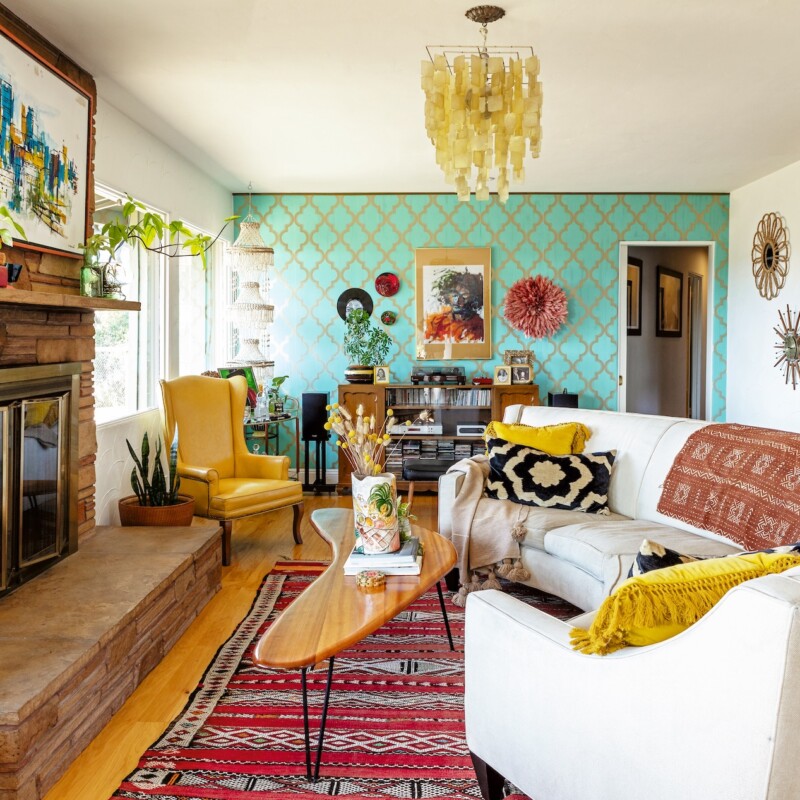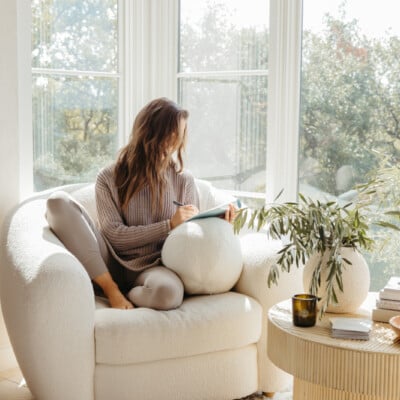On the pages of AphroChic: Celebrating the Legacy of the Black Family Home collide a myriad of truths: joy and pain; history and perseverance, and beauty and pride. Written by Jeanine Hays and Bryan Mason, the design book is a striking celebration of Black homeownership and creativity in America. It tells of challenges overcome and still faced today. “We are truly proud to have written an interior design book that has so much meaning to it,” says Hays of AphroChic.
Hays and Mason feature the homes of 16 Black American families. The husband-and-wife duo weave in narratives about personal histories, heirlooms, and family records. The book is an opportunity to learn about Black Americans’ creation and re-creation of home, adds Hays. “Home is not just about pretty rooms and fancy furniture but has a much deeper meaning—that of safety, security, preserving the past and moving toward a better future.”
With exquisite interiors and stories from artists and creatives, AphroChic celebrates eclectic design, as well as the strength of the Black American experience.
Read on to learn more about the book’s cultural and societal importance from Hays and Mason.


In AphroChic, you include stunning interiors from all over the country. What are some recurring truths around the concept of home and design that you discovered?
Jeanine Hays: What we love about all of the homes in this book is how personal they are. No two look alike. They are distinctive reflections of those who inhabit them. It’s something we don’t see in design too much, but it’s something that’s very African American. The art, the furnishings, down to the decorative objects, are unique to that family story. And that’s what home should be. It should be the space that tells your story. And the various families in this book truly embody that.


What surprised and empowered you when creating this book?
Bryan Mason: We were happily surprised with the stories that were shared with us. We conducted interviews with each family and they were so open. Many of them spoke about the first home they grew up in. Many shared stories about their grandparents and how they influenced their aesthetic. There were some challenging stories—families that had to journey north during the Great Migration to escape the violence of the Jim Crow South. And there were stories with deep meaning.
The openness helped us to tell these stories that illustrated the historical journey home for African Americans. It left us feeling truly honored to have not only these beautiful places to showcase but ethnographic and historical stories as well that tell a full story of America and showcase design through a Black lens.


You take readers through historical journeys, one of which shows how homeownership has been a dream pushed further away for Black individuals and families. What do you want readers to know about how this has shaped the concept of home for Black Americans and how this has resulted in issues—from racist urban planning to wealth disparities to discriminatory real estate tactics—that are still at play?
Mason: One thing that’s important to grasp is that it’s not simply a question of how this history has shaped and affected the concept of home for Black people but for our whole society. Black Americans don’t exist in a vacuum. Every American story impacts every American.
In touching on the first part of the question, the journey home chapters of the book introduce readers to the long road Black Americans have taken to build a home in this country. These chapters give community context to the individual stories that shows that every home in this book has been fought for, and that it has not been an easy road. These families are up against intentional systemic challenges, and the struggle continues. They also show the collective strength, resilience, and creativity that our community has shown over generations of enforced struggle to create a concept and feeling of home.
In approaching the question’s second point, these same chapters highlight not only the effect of redlining, gentrification, eminent domain and now COVID-related evictions as continuing plagues on the African American community, they also highlight they ways in which our society is structured to ensure that Black Americans—homeowners or not—are specifically positioned by our society to take the worst of every harmful event, from the Great Depression to the Great Recession, Hurricane Katrina to COVID-19 and everything in between.
There are fewer Black homeowners today than there were before the Fair Housing Act was enacted in 1968. This is due to systemic racism and largely attributable to the predatory housing and lending practices that led to the crash of ‘08. Meanwhile these disparities in homeownership, long the cornerstone of building the American middle class, make up significant parts of the massive gap in wealth and inheritance that separates Black and white communities.
We hope people take away from this book a new way of looking at design and ultimately what home means. Home is sanctuary, a personal space that can reflect you and your story. And for African Americans, home is the continuous fight to be free in the country that was literally built on the backs of our ancestors. — Bryan Mason
We find opportunities to look at how the journey home chapters tell that story. They lead you to understand that there is still a long way to go. It’s why every Black home must be celebrated. Because those who have attained home did so in the face of, as the ancestors said, “a mighty long road to climb.”


Reprinted with permission from AphroChic: Celebrating the Legacy of the Black Family Home. Copyright © 2022 by Jeanine Hays and BryanMason. Photographs copyright © 2022 by Patrick Cline.






